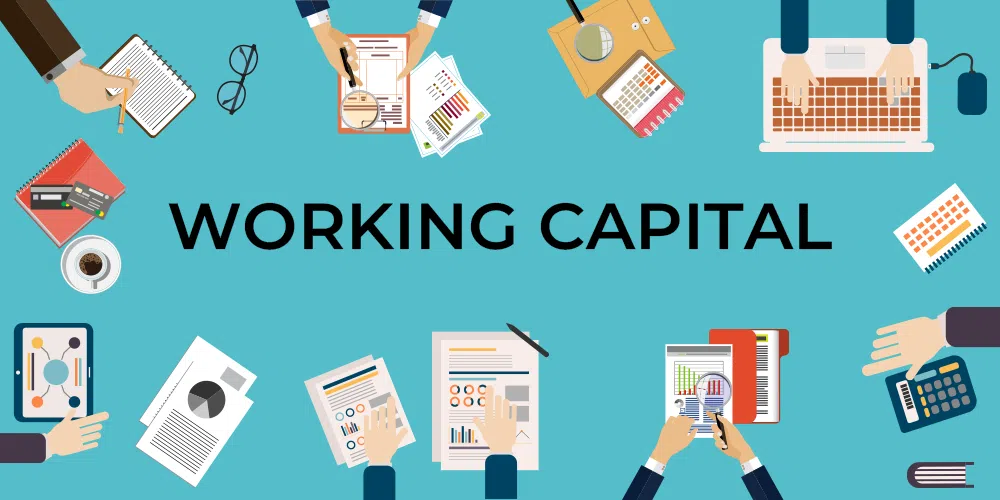Working capital represents a company’s ability to pay its current liabilities with its current assets. This figure gives investors an indication of the company’s short-term financial health, capacity to clear its debts within a year, and operational efficiency.
Working capital is the difference between a company’s current assets and current liabilities. The challenge here is determining the proper category for the vast array of assets and liabilities on a corporate balance sheet so as to decipher the overall health of a company and its ability to meet its short-term commitments.

What Is Working Capital?
Working capital, also known as net working capital (NWC), is the difference between a company’s current assets—such as cash, accounts receivable/customers’ unpaid bills, and inventories of raw materials and finished goods—and its current liabilities, such as accounts payable and debts. It’s a commonly used measurement to gauge the short-term health of an organization.
Working capital estimates are derived from the array of assets and liabilities on a corporate balance sheet. By only looking at immediate debts and offsetting them with the most liquid of assets, a company can better understand what sort of liquidity it has in the near future.Working capital is also a measure of a company’s operational efficiency and short-term financial health. If a company has substantial positive NWC, then it could have the potential to invest in expansion and grow the company. If a company’s current assets do not exceed its current liabilities, then it may have trouble growing or paying back creditors. It might even go bankrupt.
Working Capital Formula
To calculate working capital, subtract a company’s current liabilities from its current assets. Both figures can be found in the publicly disclosed financial statements for public companies, though this information may not be readily available for private companies.
Working Capital = Current Assets – Current Liabilities
Working capital is often stated as a dollar figure. For example, say a company has $100,000 of current assets and $30,000 of current liabilities. The company is therefore said to have $70,000 of working capital. This means the company has $70,000 at its disposal in the short term if it needs to raise money for a specific reason.When a working capital calculation is positive, this means the company’s current assets are greater than its current liabilities. The company has more than enough resources to cover its short-term debt, and there is residual cash should all current assets be liquidated to pay this debt.When a working capital calculation is negative, this means the company’s current assets are not enough to pay for all of its current liabilities. The company has more short-term debt than it has short-term resources. Negative working capital is an indicator of poor short-term health, low liquidity, and potential problems paying its debt obligations as they become due.It is worth noting that negative working capital is not always a bad thing; it can be good or bad, depending on the specific business and its stage in its lifecycle; however, prolonged negative working capital can be problematic.
Components of Working Capital
Current Assets- Current assets are economic benefits that the company expects to receive within the next 12 months. The company has a claim or right to receive the financial benefit, and calculating working capital poses the hypothetical situation of the company liquidating all items below into cash.
- Cash and Cash Equivalents: All of the money the company has on hand. This includes foreign currency and certain types of investments such as money market accounts with very low risk and very low investment term periods.
- Inventory: All of the unsold goods being stored. This includes raw materials purchased to manufacture, partially assembled inventory that is in process, and finished goods that have not yet been sold.
- Accounts Receivable: All of the claims to cash for inventory items sold on credit. This should be included net of any allowance for doubtful payments.
- Notes Receivable: All of the claims to cash for other agreements, often agreed to through a physically signed agreement.
- Prepaid Expenses: All of the value for expenses paid in advance. Though it may be difficult to liquidate these in the event of needing cash, they still carry short-term value and are included.
- Others: Any other short-term asset. An example is some companies may recognize a short-term deferred tax asset that reduces a future liability.
Current Liabilities- Current liabilities are simply all debts a company owes or will owe within the next twelve months. The overarching goal of working capital is to understand whether a company will be able to cover all of these debts with the short-term assets it already has on hand.
- Accounts Payable: All unpaid invoices to vendors for supplies, raw materials, utilities, property taxes, rent, or any other operating expense owed to an outside third party. Credit terms on invoices are often net 30 days, so essentially all invoices are captured here.
- Wages Payable: All unpaid accrued salary and wages for staff members. Depending on the timing of the company’s payroll, this may only accrue up to one month’s worth of wages (if the company only issues one paycheck per month). Otherwise, these liabilities are very short-term in nature.
- Current Portion of Long-Term Debt: All short-term payments related to long-term debt. Imagine a company finances its warehouse and owes monthly debt payments on the 10-year debt. The next 12 months of payments are considered short-term debt, while the remaining 9 years of payments are long-term debt. Only 12 months are included when calculating working capital.
- Accrued Tax Payable: All obligations to government bodies. These may be accruals for tax obligations for filings not due for months; however, these accruals are usually always short-term (due within the next 12 months) in nature.
- Dividend Payable: All authorized payments to shareholders. A company may decide to decline future dividend payments but must fulfill obligations on already authorized dividends.
- Unearned Revenue: All capital received in advance of having completed work. Should the company fail to complete the job, it may be forced to return capital back to the client.
Limitations of Working Capital
Working capital can be very insightful to determine a company’s short-term health. However, there are some downsides to the calculation that make the metric sometimes misleading.
First, working capital is always changing. If a company is fully operating, it’s likely that several—if not most—current asset and current liability accounts will change. Therefore, by the time financial information is accumulated, it’s likely that the working capital position of the company has already changed.Working capital fails to consider the specific types of underlying accounts. For example, imagine a company whose current assets are 100% in accounts receivable. Though the company may have positive working capital, its financial health depends on whether its customers will pay and whether the business can come up with short-term cash.On a similar note, assets can quickly become devalued. Accounts receivable balances may lose value if a top customer files for bankruptcy. Inventory is at-risk of obsolescence or theft. Physical cash is also at risk of theft. Therefore, a company’s working capital may change simply based on forces outside of its control.
Last, working capital assumes all debt obligations are known. In mergers or very fast-paced companies, agreements can be missed or invoices can be processed incorrectly. Working capital relies heavily on correct accounting practices, especially surrounding internal control and safeguarding of assets.
FAQs
Is Negative Working Capital Bad?
It depends. Generally, it is bad if a company’s current liabilities balance exceeds its current asset balance. This means the company does not have enough resources in the short-term to pay off its debts, and it must get creative in finding a way to make sure it can pay its short-term bills on time. A short-period of negative working capital may not be an issue depending on a company’s place in its business life cycle and if it is able to generate cash quickly to pay off debts.
How Does a Company Calculate Working Capital?
Simply take the company’s total amount of current assets and subtract from that figure its total amount of current liabilities. The result is the amount of working capital that the company has at that point in time. Working capital amounts can change.
What Does Working Capital Indicate?
Working capital is the amount of current assets that’s left over after subtracting current liabilities. It’s what can quickly be converted to cash to pay short-term debts. Working capital can be a barometer for a company’s short-term liquidity. A positive amount of working capital indicates good short-term health. A negative amount of working capital indicates that a company may face liquidity challenges and may have to incur debt to pay its bills.
Practice area's of B K Goyal & Co LLP
Income Tax Return Filing | Income Tax Appeal | Income Tax Notice | GST Registration | GST Return Filing | FSSAI Registration | Company Registration | Company Audit | Company Annual Compliance | Income Tax Audit | Nidhi Company Registration| LLP Registration | Accounting in India | NGO Registration | NGO Audit | ESG | BRSR | Private Security Agency | Udyam Registration | Trademark Registration | Copyright Registration | Patent Registration | Import Export Code | Forensic Accounting and Fraud Detection | Section 8 Company | Foreign Company | 80G and 12A Certificate | FCRA Registration |DGGI Cases | Scrutiny Cases | Income Escapement Cases | Search & Seizure | CIT Appeal | ITAT Appeal | Auditors | Internal Audit | Financial Audit | Process Audit | IEC Code | CA Certification | Income Tax Penalty Notice u/s 271(1)(c) | Income Tax Notice u/s 142(1) | Income Tax Notice u/s 144 |Income Tax Notice u/s 148 | Income Tax Demand Notice | Psara License | FCRA Online
Company Registration Services in major cities of India
Company Registration in Jaipur | Company Registration in Delhi | Company Registration in Pune | Company Registration in Hyderabad | Company Registration in Bangalore | Company Registration in Chennai | Company Registration in Kolkata | Company Registration in Mumbai | Company Registration in India | Company Registration in Gurgaon | Company Registration in Noida | Company Registration in lucknow
Complete CA Services
RERA Services
Most read resources
tnreginet |rajssp | jharsewa | picme | pmkisan | webland | bonafide certificate | rent agreement format | tax audit applicability | 7/12 online maharasthra | kerala psc registration | antyodaya saral portal | appointment letter format | 115bac | section 41 of income tax act | GST Search Taxpayer | 194h | section 185 of companies act 2013 | caro 2020 | Challan 280 | itr intimation password | internal audit applicability | preliminiary expenses | mAadhar | e shram card | 194r | ec tamilnadu | 194a of income tax act | 80ddb | aaple sarkar portal | epf activation | scrap business | brsr | section 135 of companies act 2013 | depreciation on computer | section 186 of companies act 2013 | 80ttb | section 115bab | section 115ba | section 148 of income tax act | 80dd | 44ae of Income tax act | west bengal land registration | 194o of income tax act | 270a of income tax act | 80ccc | traces portal | 92e of income tax act | 142(1) of Income Tax Act | 80c of Income Tax Act | Directorate general of GST Intelligence | form 16 | section 164 of companies act | section 194a | section 138 of companies act 2013 | section 133 of companies act 2013
